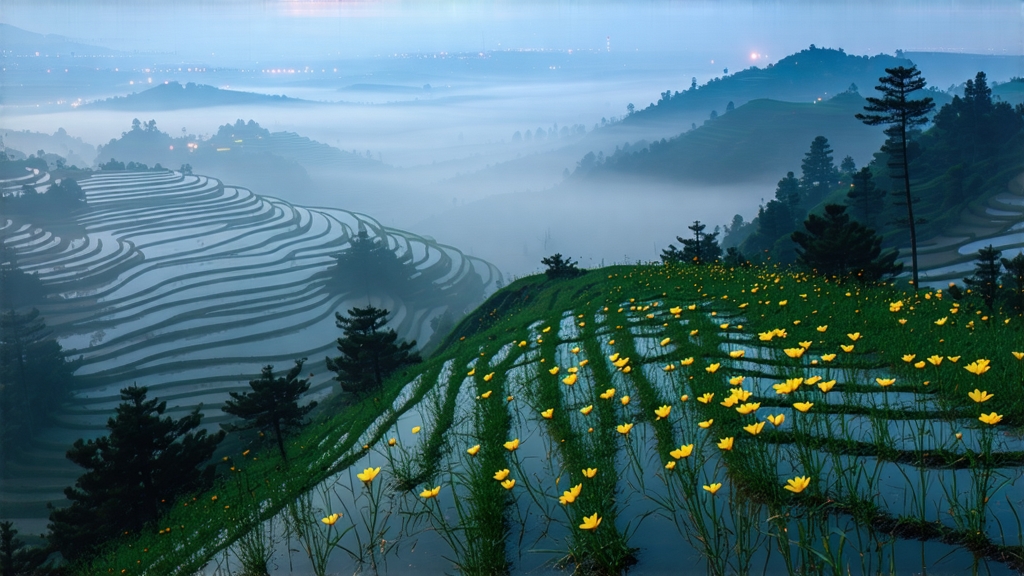
Meng Ding Huang Ya, literally “Yellow Bud from Meng Peak,” is the least-traveled jewel among China’s six major tea families. While green tea commands the world’s attention and pu-erh fills collectors’ vaults, this yellow-fermented treasure from the mist-capped Meng Ding range of Sichuan has quietly preserved the palate of Tang-dynasty emperors for thirteen centuries. To meet it is to taste history suspended between green freshness and red warmth, a flavor that arrives like morning sunlight filtered through bamboo leaves—soft, luminous, slightly honeyed, and inexplicably ancient.
History: A Courtship of Mist and Monarchs
Tea texts from 808 CE already record “Meng Mountain Yellow Sprout” as tribute, carried by mule caravan down narrow plank roads to Chang-an. Song dynasty connoisseur Song Zi’an ranked it “first among the buds,” and Ming imperial menus list it beside leopard-fetus broth and swallows-nest soup. The Qing turned away from yellow teas in favor of fragrant greens, and Meng Ding Huang Ya retreated into monasteries, where monks perfected the micro-fermentation technique called “sealed yellowing.” Only in 1959 did the state re-introduce it to global fairs, yet even today annual production is less than three tons, most reserved for Beijing’s state guesthouse.
Terroir: Where Clouds Root in Granite
Meng Ding summit, 1 456 m above Chengdu’s basin, inhales the Sichuan fog twelve months a year. The classic micro-climate—80 % humidity, 14 °C mean, basaltic soil rich in potassium—forces tea bushes to synthesize more theanine and less catechins, yielding a naturally sweet, low-astringent leaf. The prized plots face east above the “Sweet Dew” (Gan Lu) temple, where bamboo groves bounce diffused light back onto the bushes, creating an even, jade-yellow chlorophyll profile impossible to replicate at lower elevations.
Plucking: One Leaf, One Heart, Before the Monks Ring the Bell
Harvest begins on the first Wednesday after Qing Ming, when morning mist still beads on rows of the local “old-root” cultivar (Camellia sinensis var. sinensis ‘Gan Lu #1’). Pickers—usually women whose families have worked the same terraces for ten generations—snap only the single unopened bud plus the half-unfurled first leaf, a standard known as “sparrow’s tongue.” Anything longer than 2.5 cm is rejected; anything shorter lacks the enzymatic heft needed for yellowing. A full day’s pluck fills only half a bamboo basket, about 500 g fresh weight.
Craft: The Art of Letting the Leaf Sweat
Meng Ding Huang Ya’s identity is forged during the 72-hour “sealed yellowing” phase, a controlled micro-oxidation that sits stylistically between green tea’s kill-green and white tea’s withering. The sequence unfolds in five precise steps:
- Pan-firing (shaqing): 220 °C for 3 min on cast-iron turtle-shell pans, hand-tossed to deactivate 70 % of polyphenol oxidase while preserving 30 % for later transformation.
- Initial rolling: 8 min under 6 N pressure to rupture 35 % of cell walls without breaking surface hairs.
- First wrap (menhuang): 4 kg of hot leaves are piled inside a linen sleeve, tied, and slid into a 40 °C bamboo chamber for 4 h; humidity 85 %. The leaf “sweats,” turning from jade to pale primrose.
- Second firing & re-wrap: temperature dropped to 80 °C, 2 min refire, then re-wrapped for another 6 h. Aromas shift from cut grass to steamed corn milk.
- Slow drying over charcoal embers: 60 °C for 3 h while artisans roll each bud between cotton cloth to set the curved “eyebrow” shape and lock in a faint golden down.
The finished tea contains 5–7 % residual moisture, enough to continue a glacial post-fermentation that will deepen sweetness for five years if stored below 8 °C.
Grades: Three Palaces of Buds
- Imperial Sparrow Tongue: 100 % single buds, picked within the first 48 h, downy and lemon-cream in color;